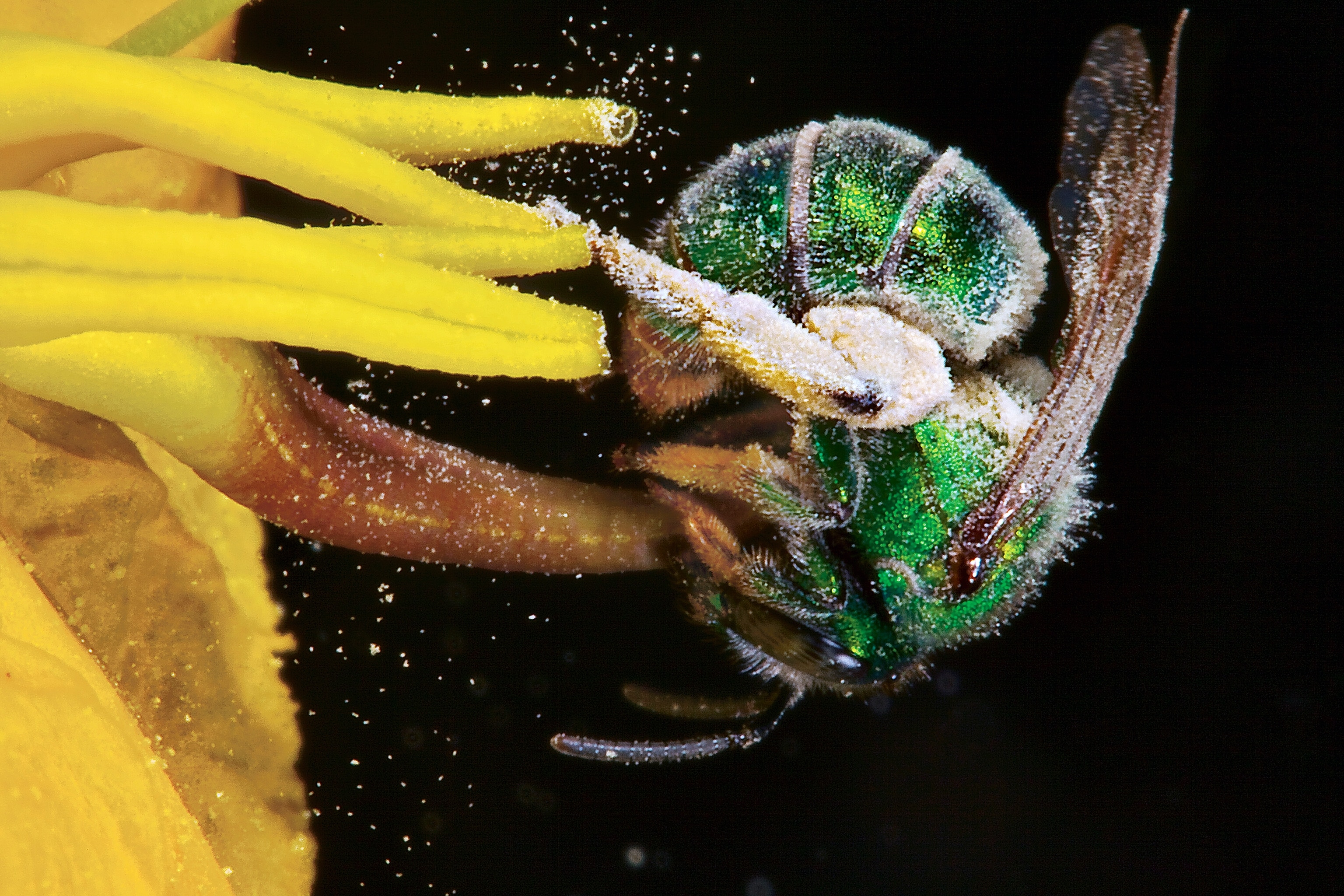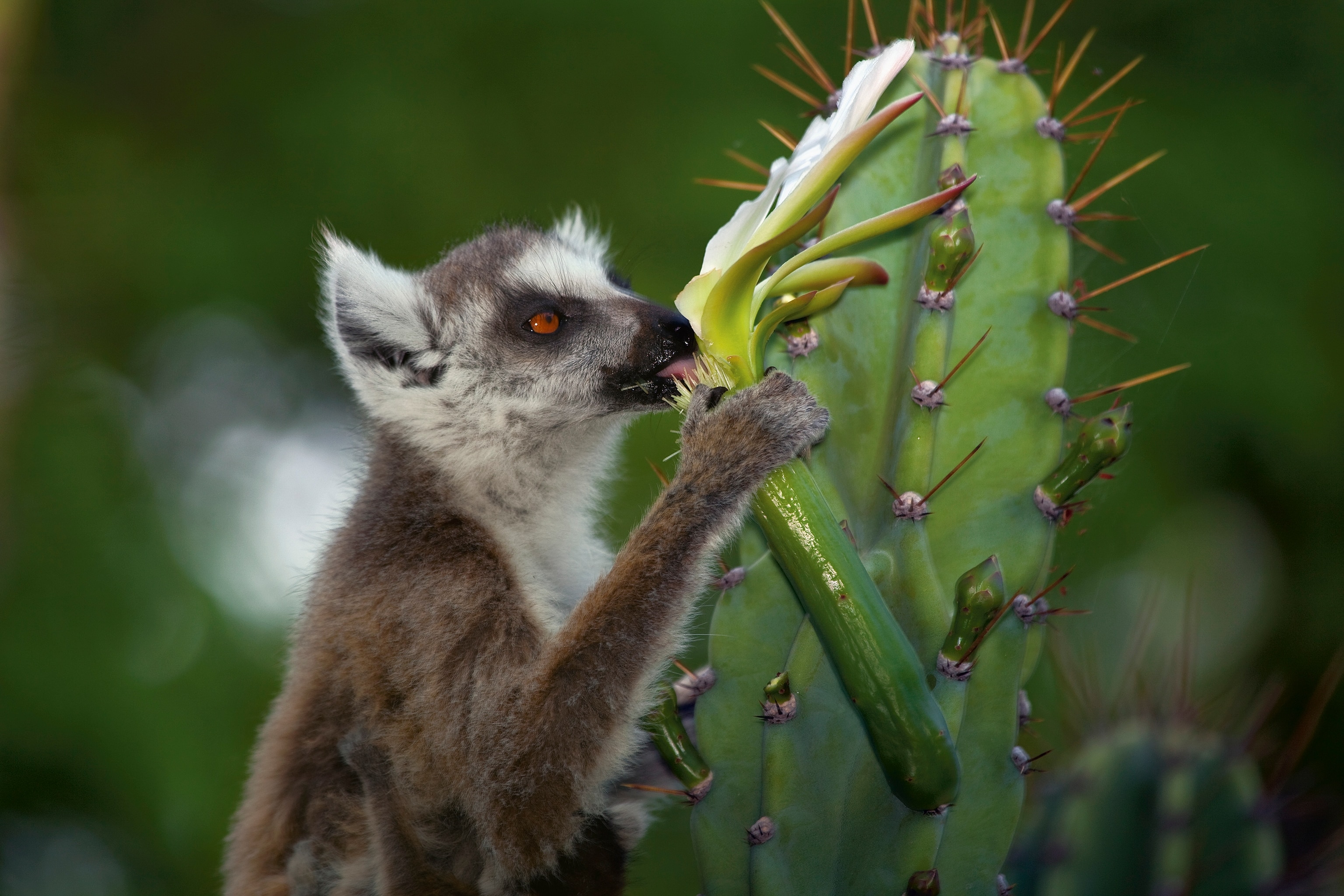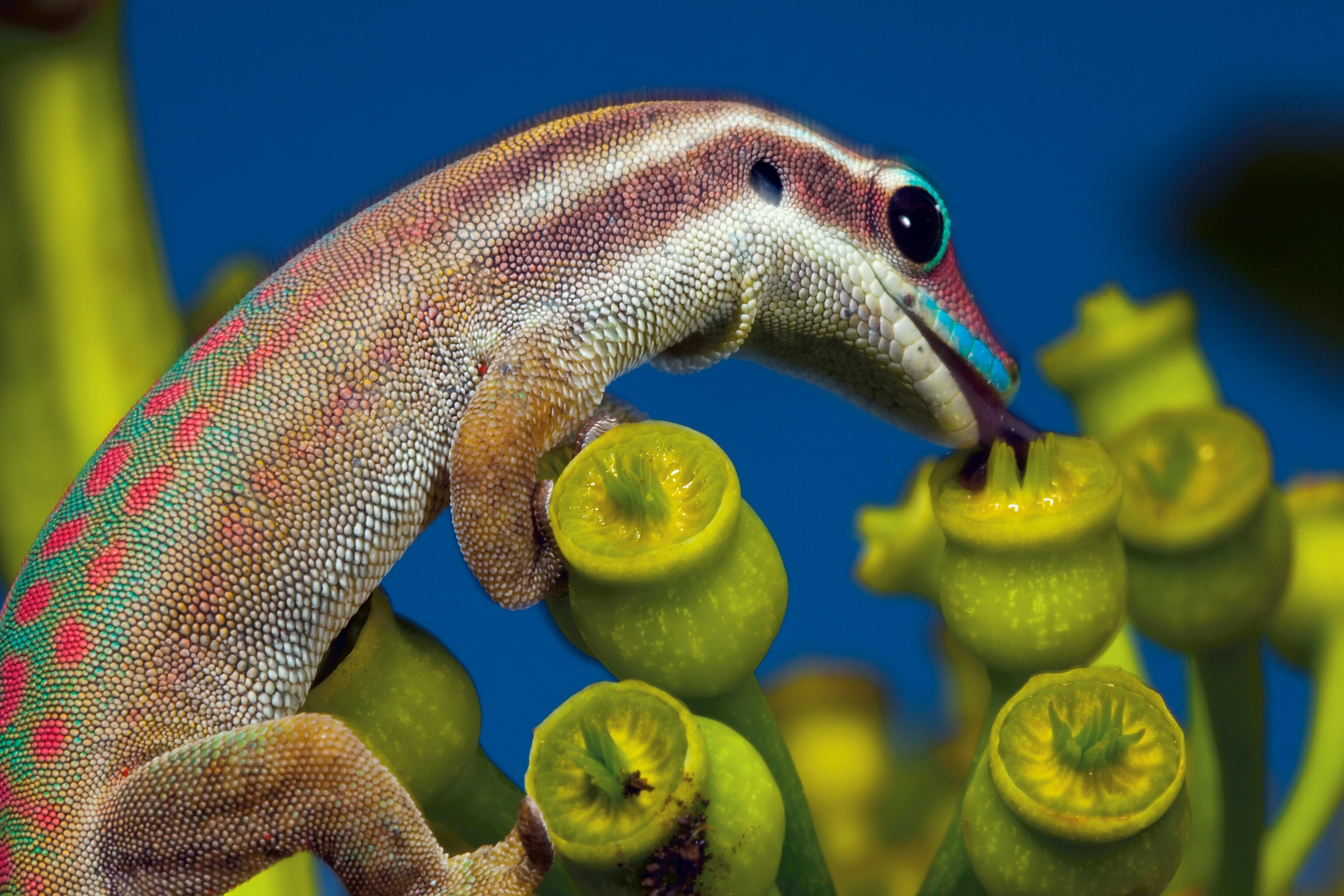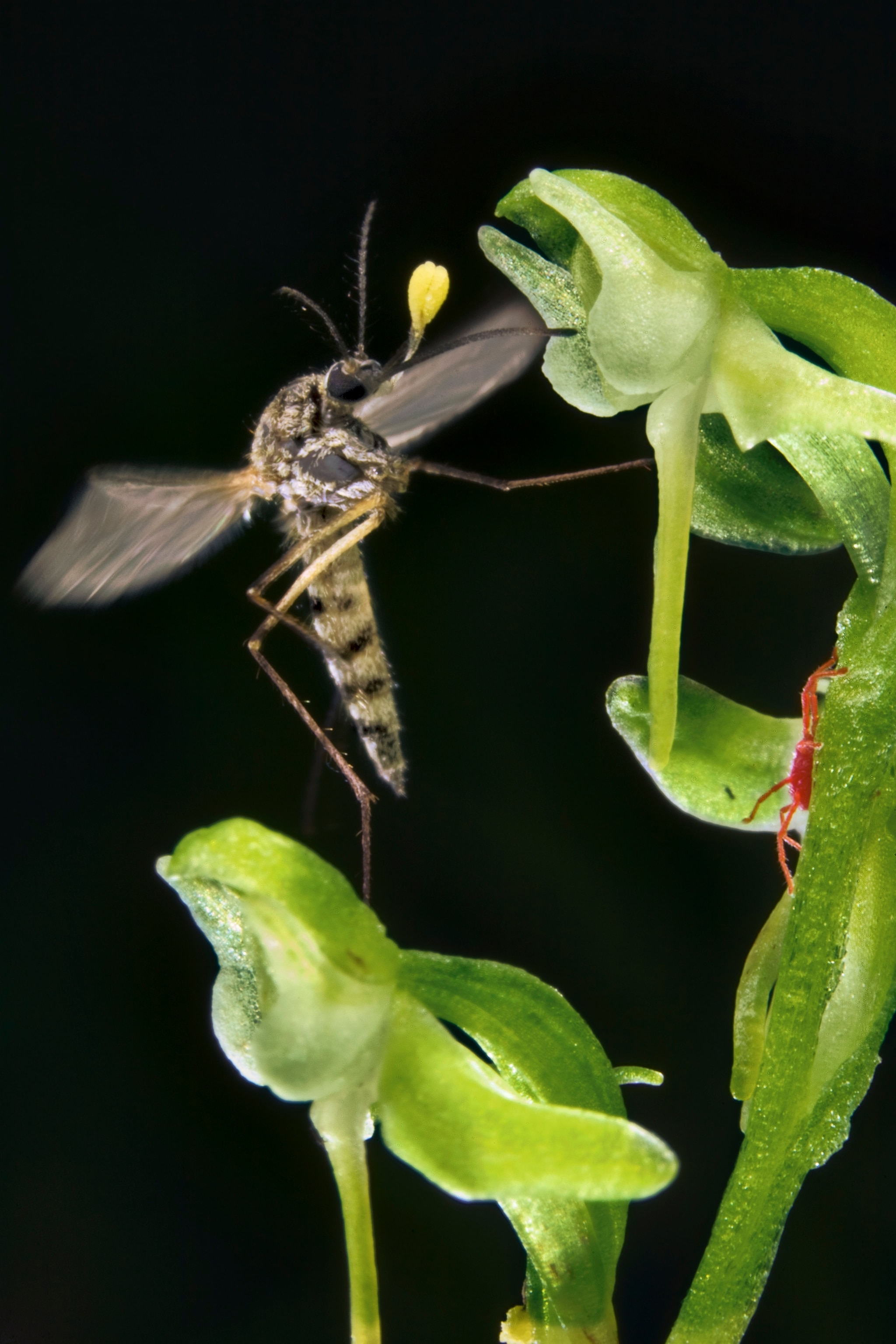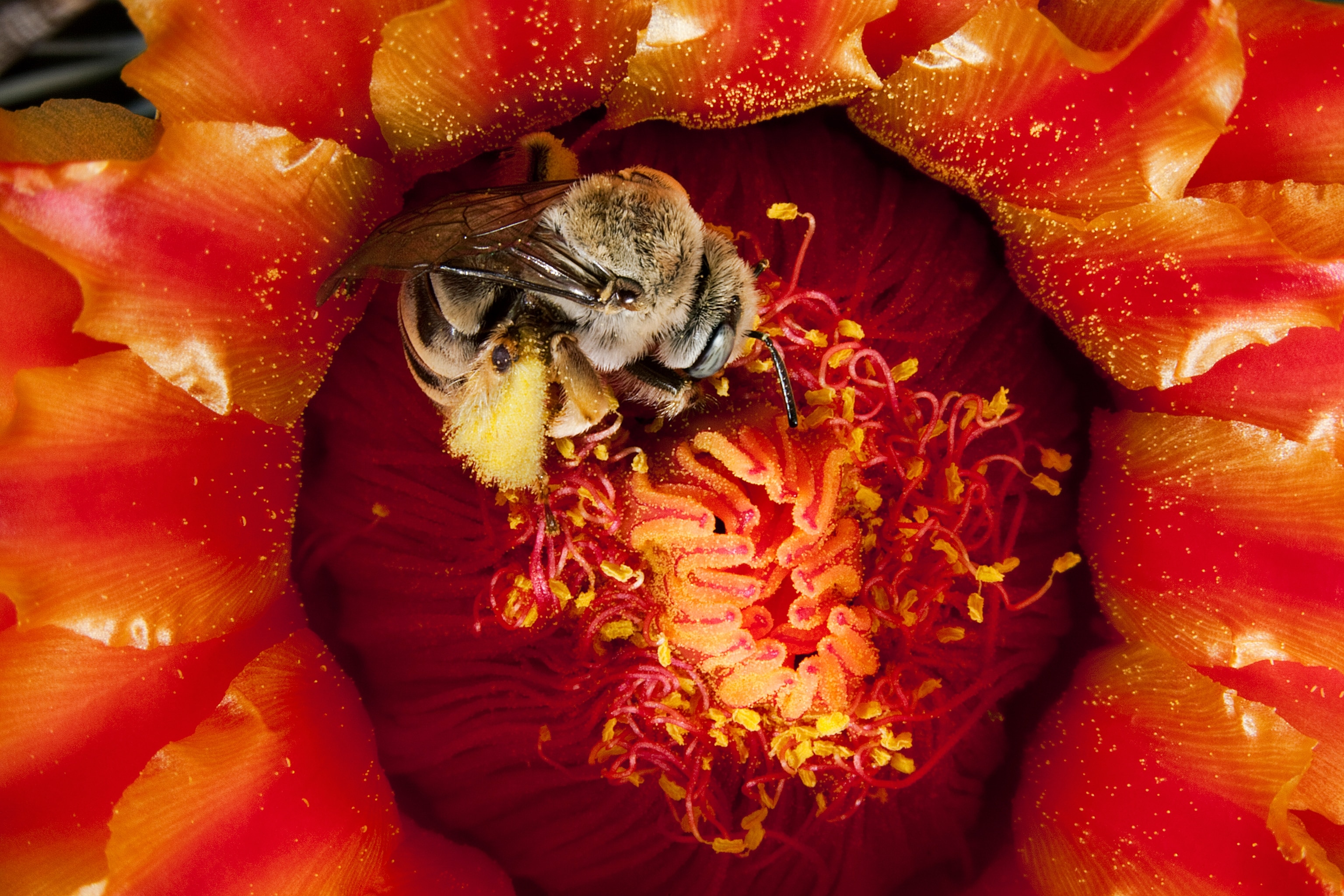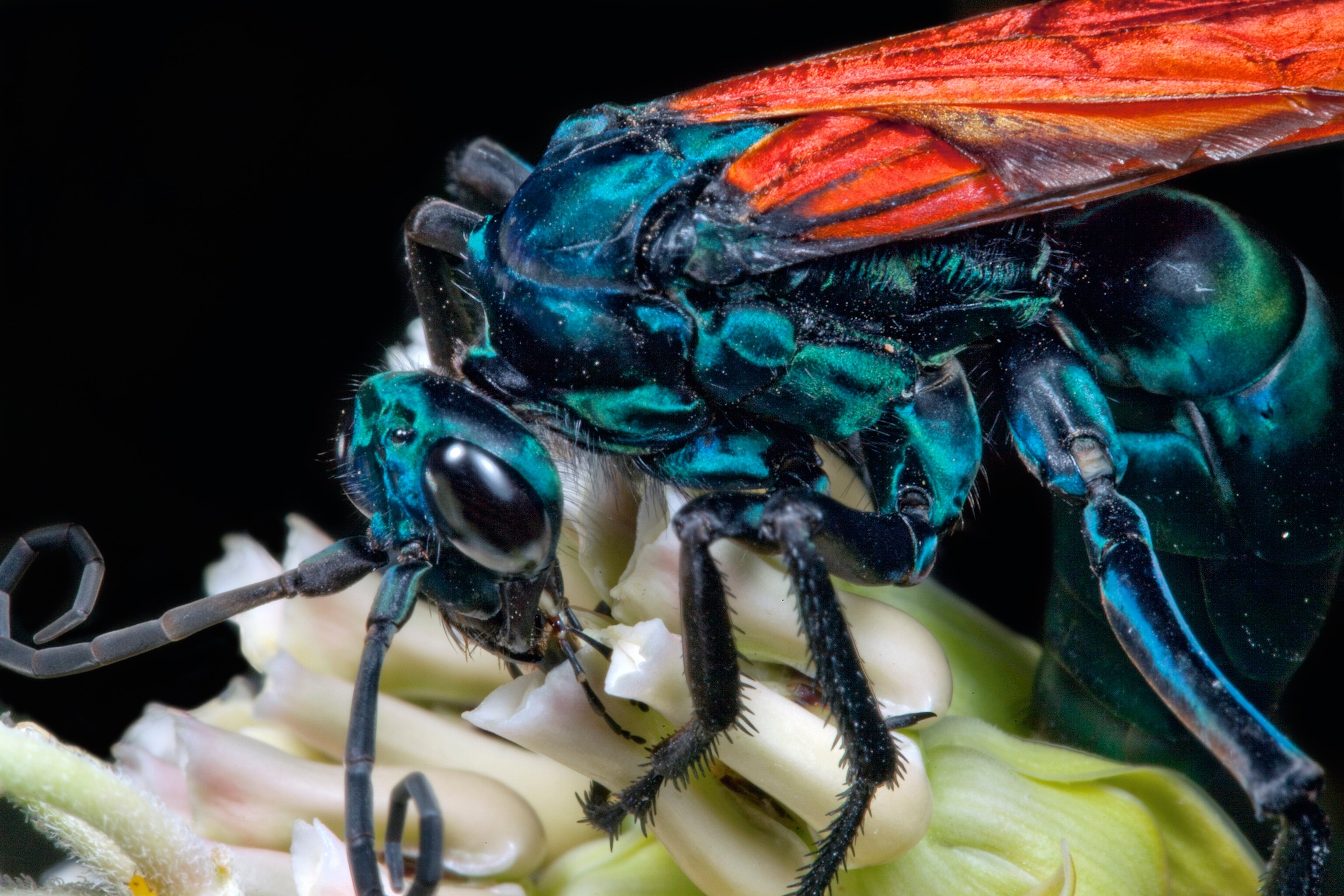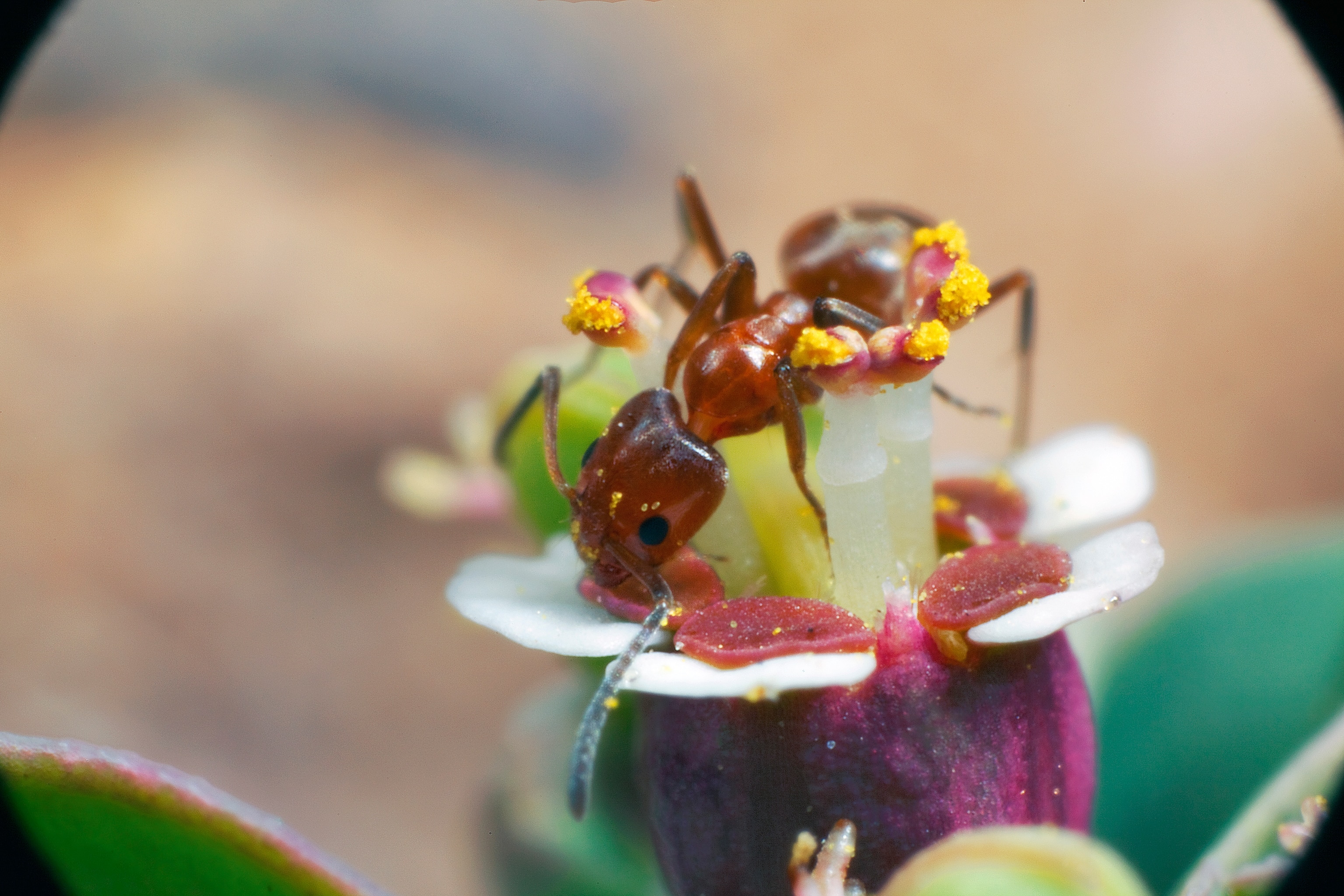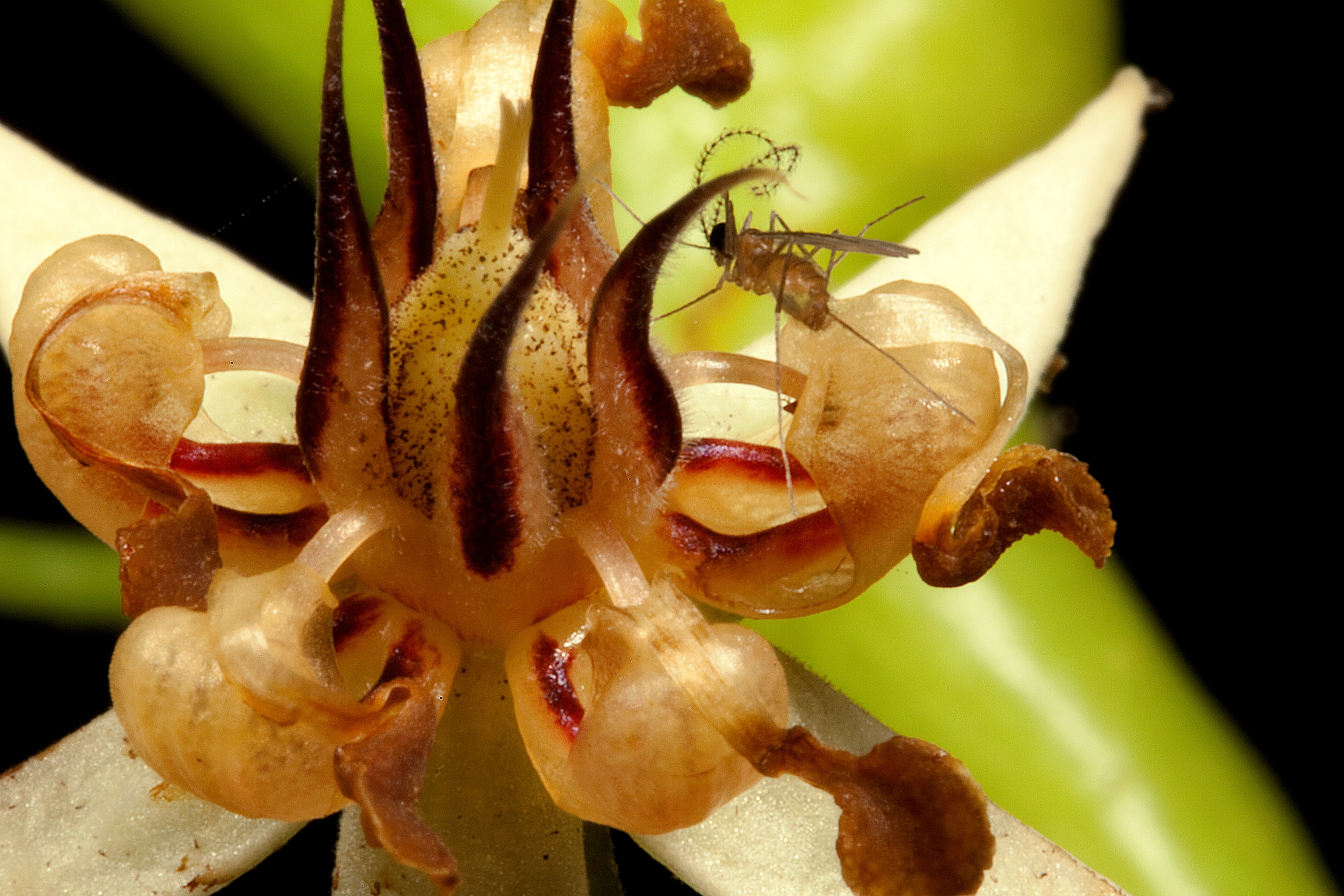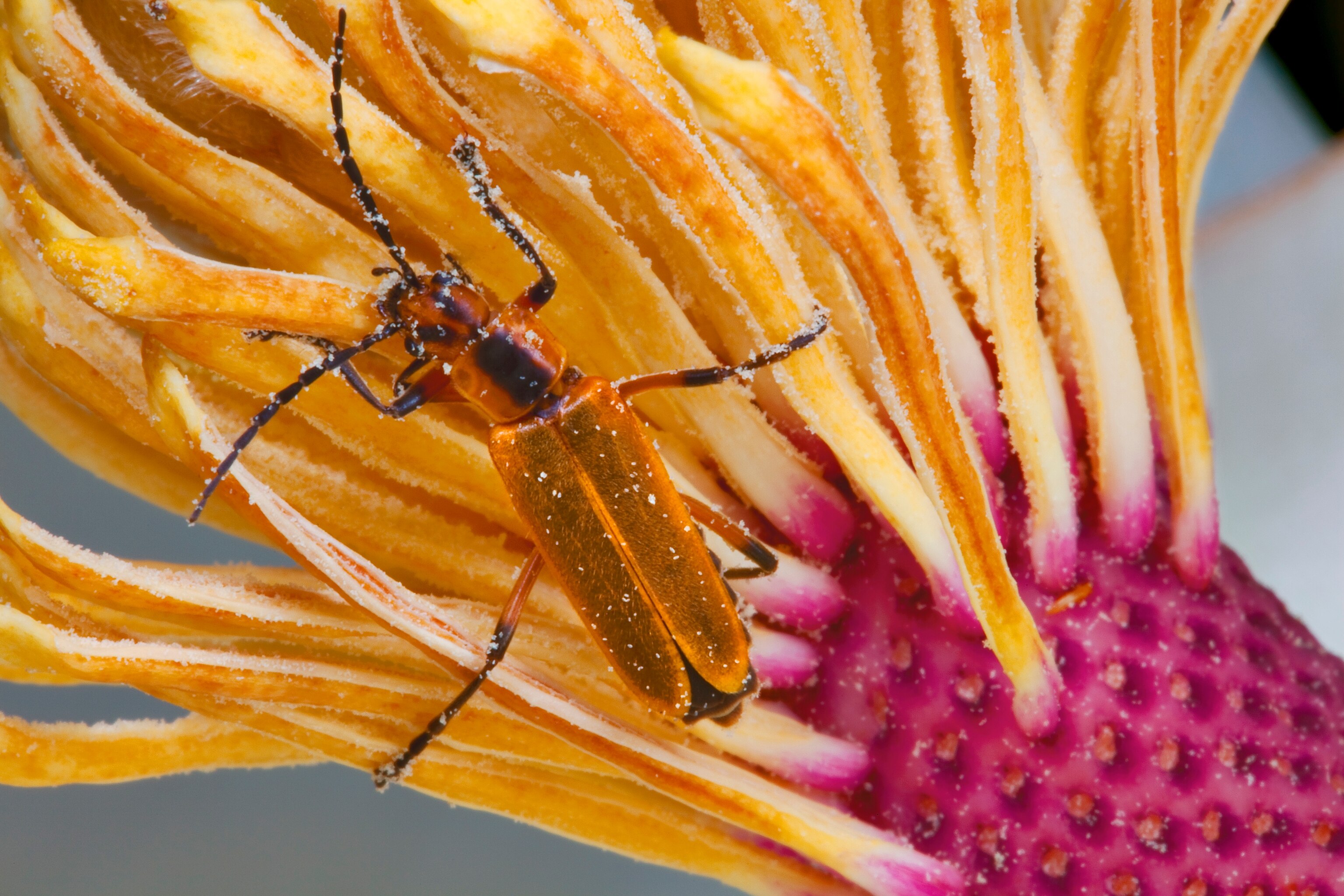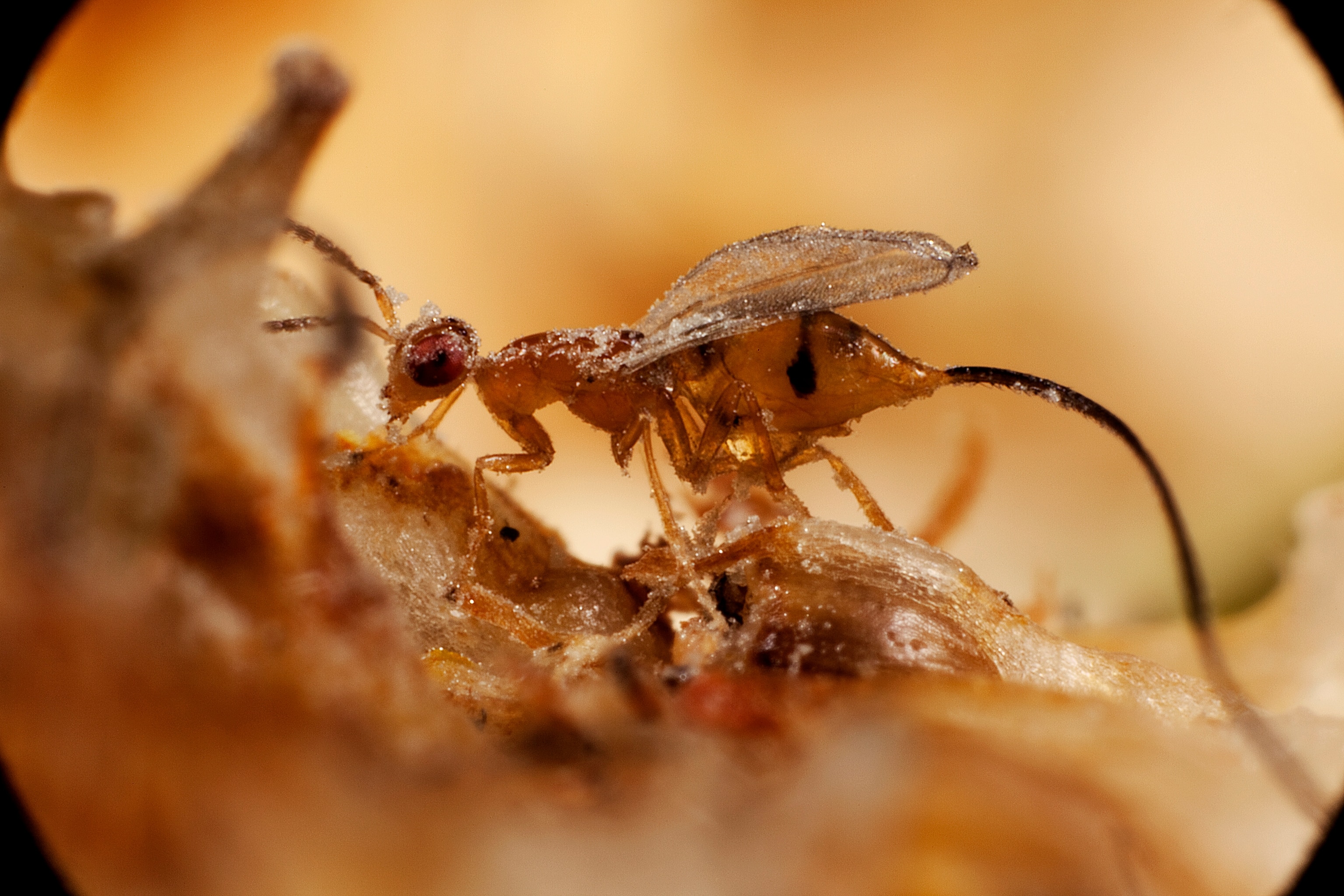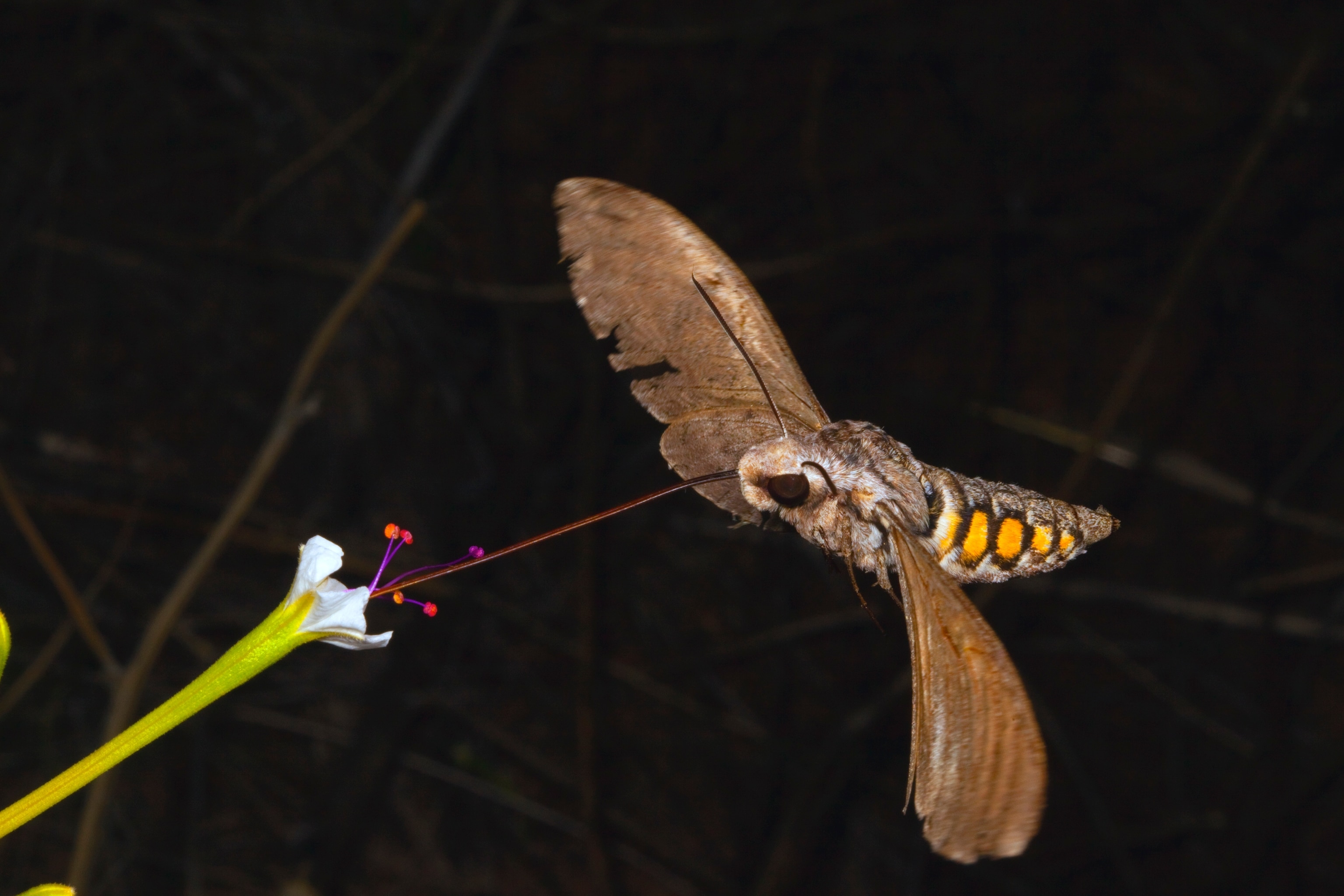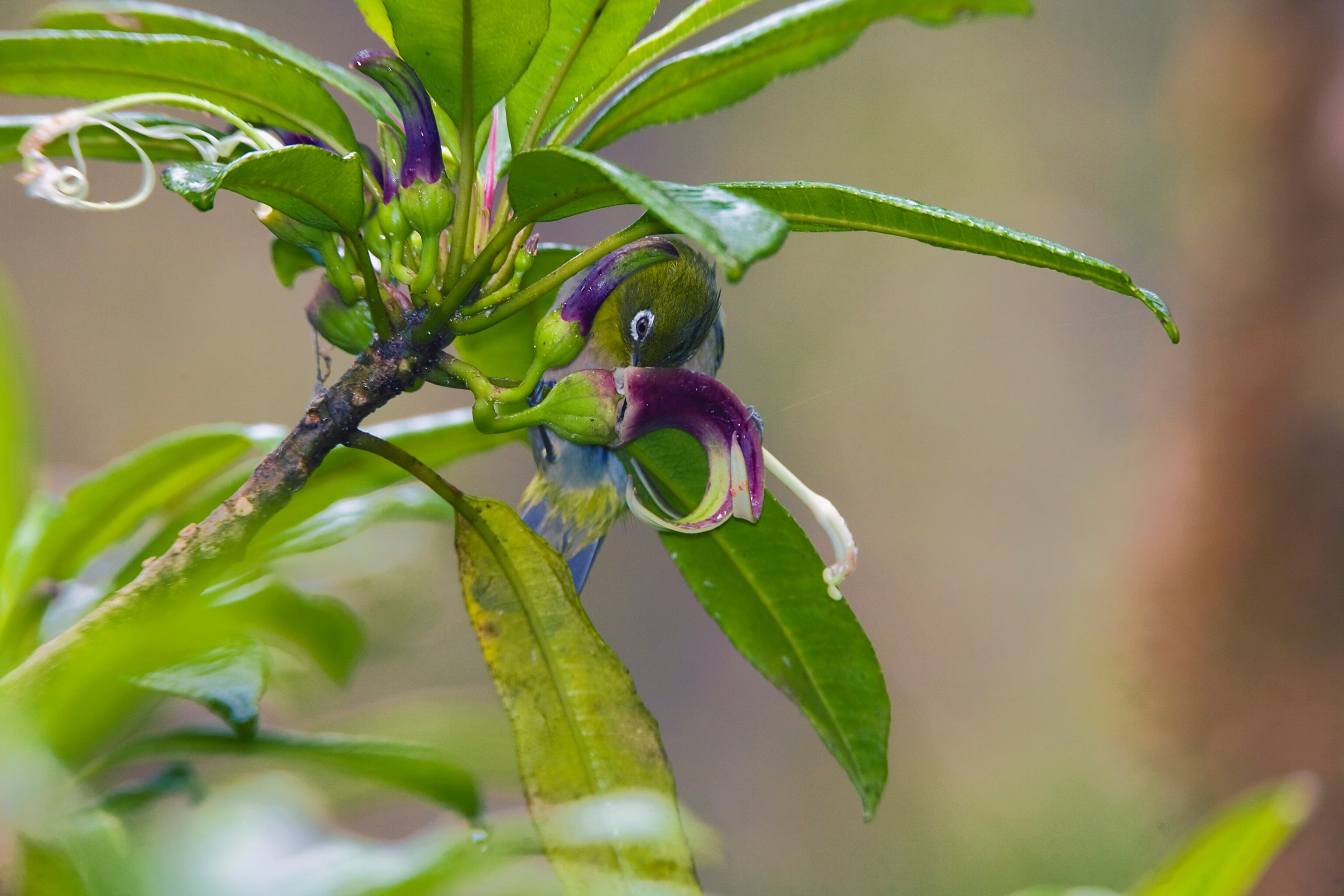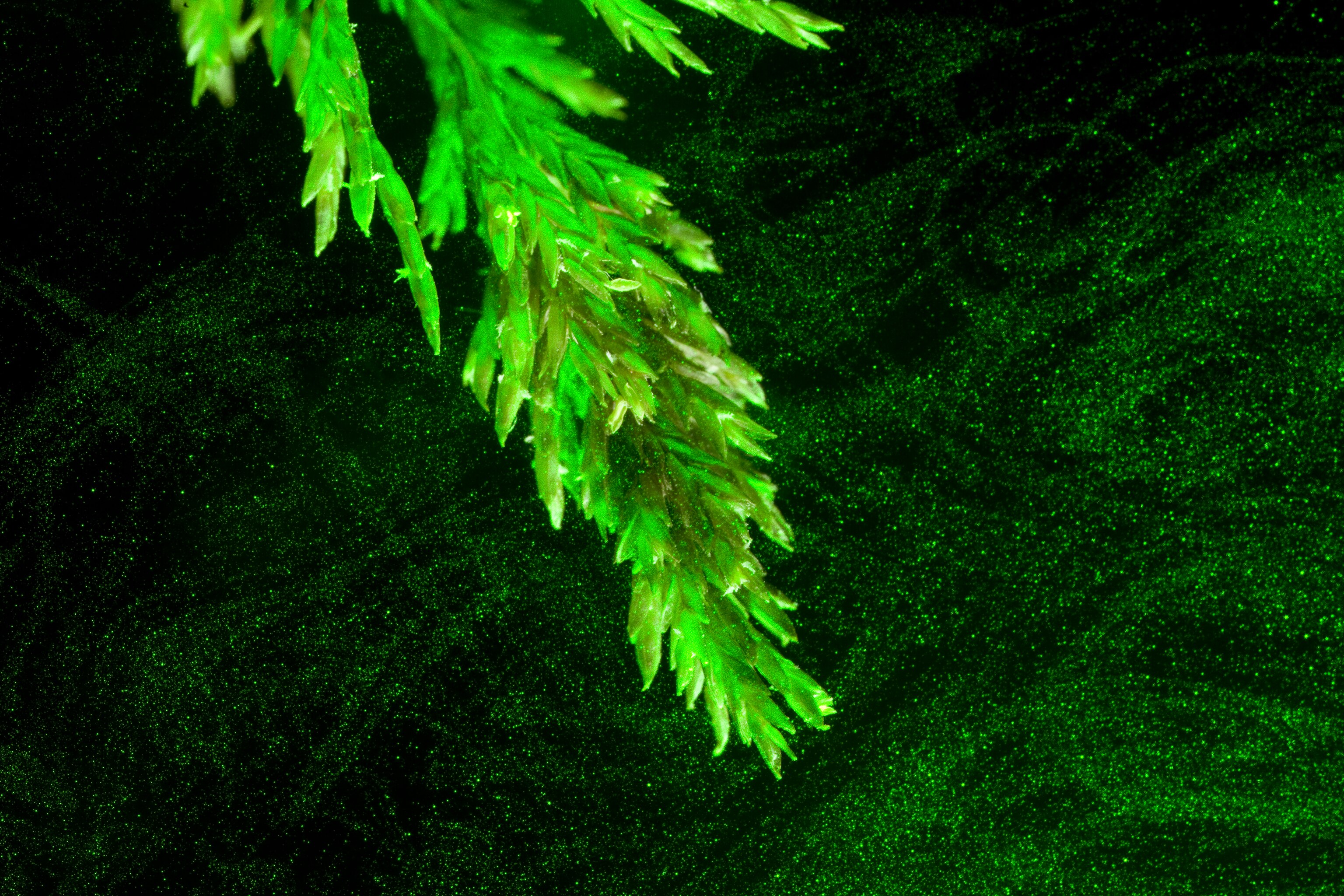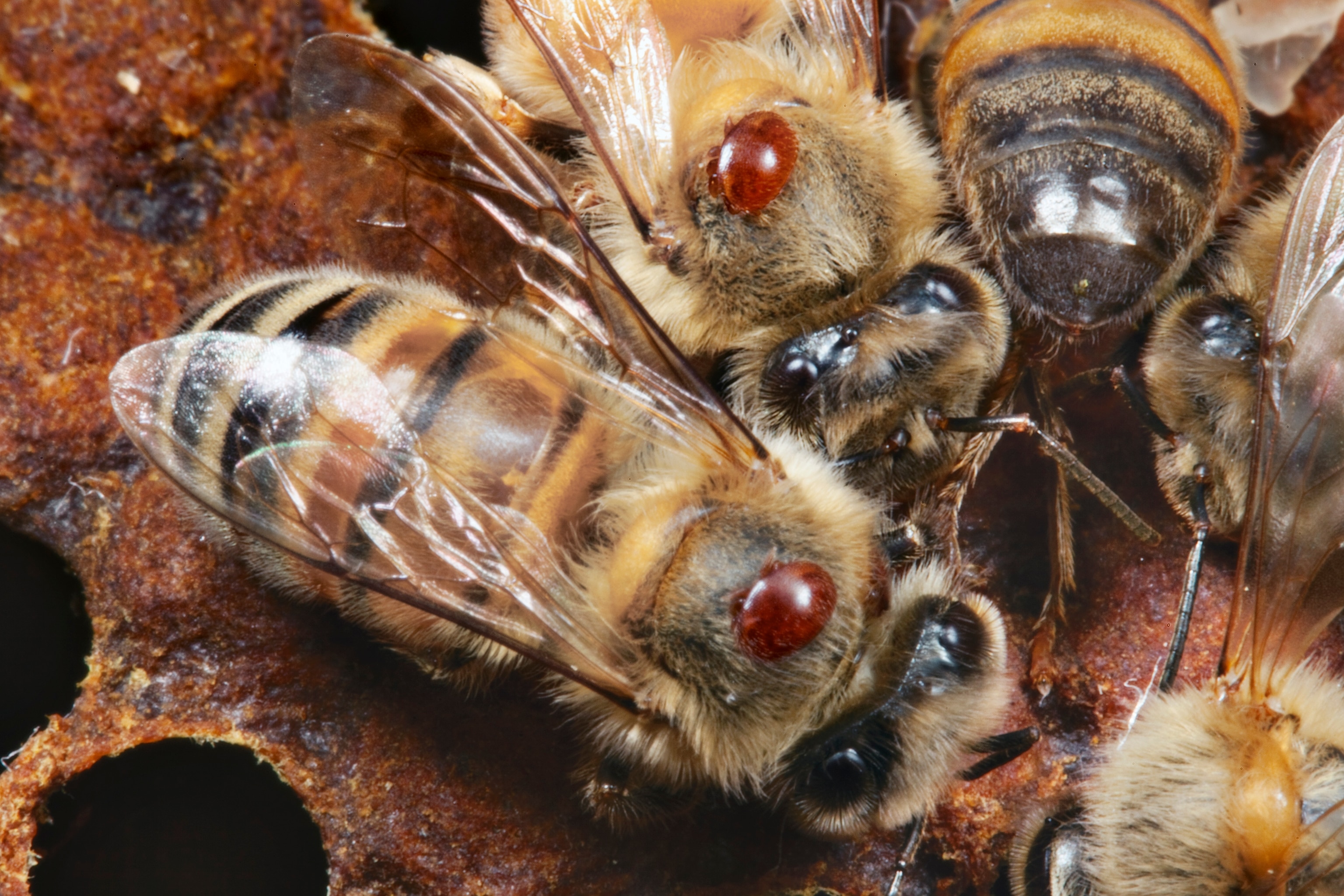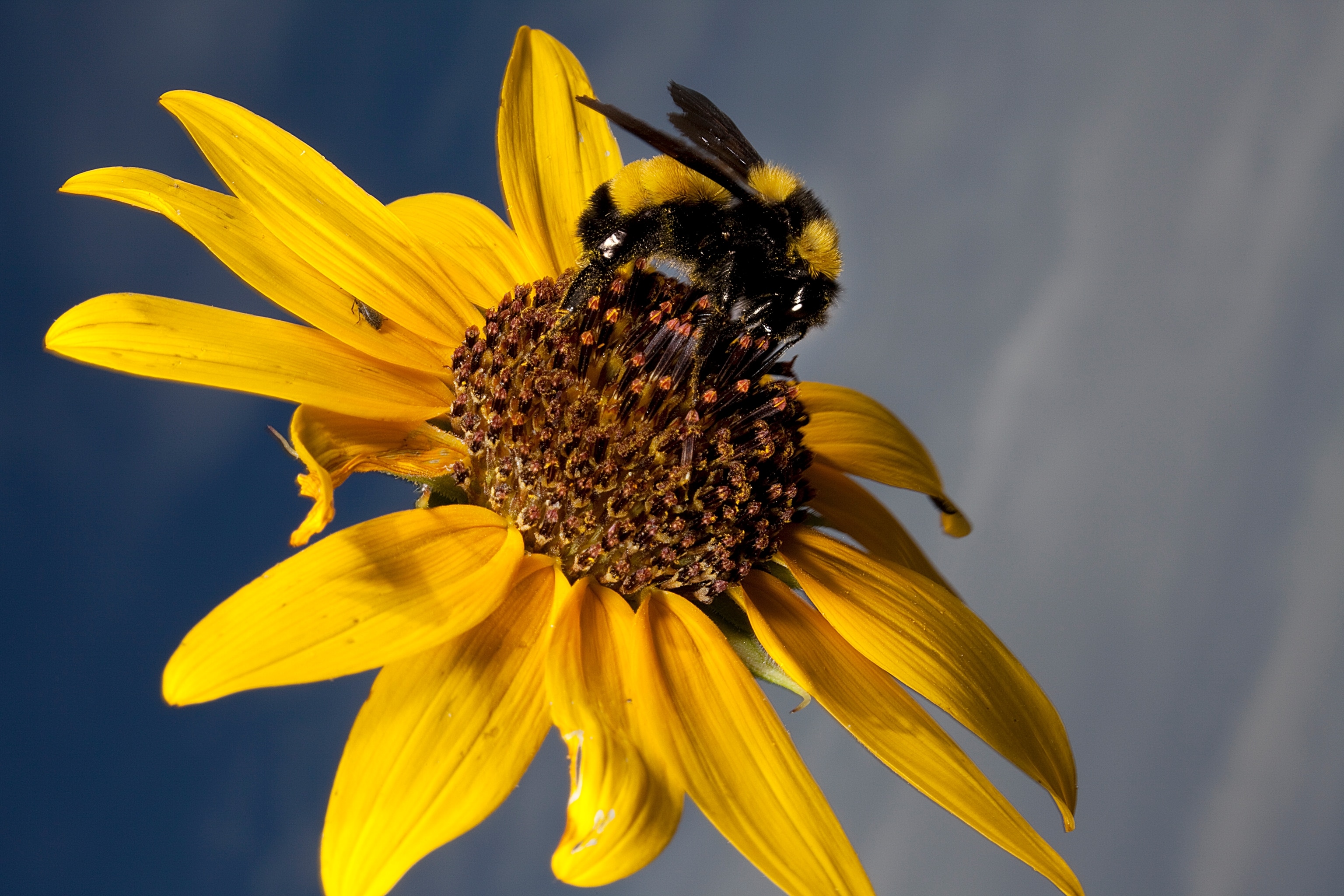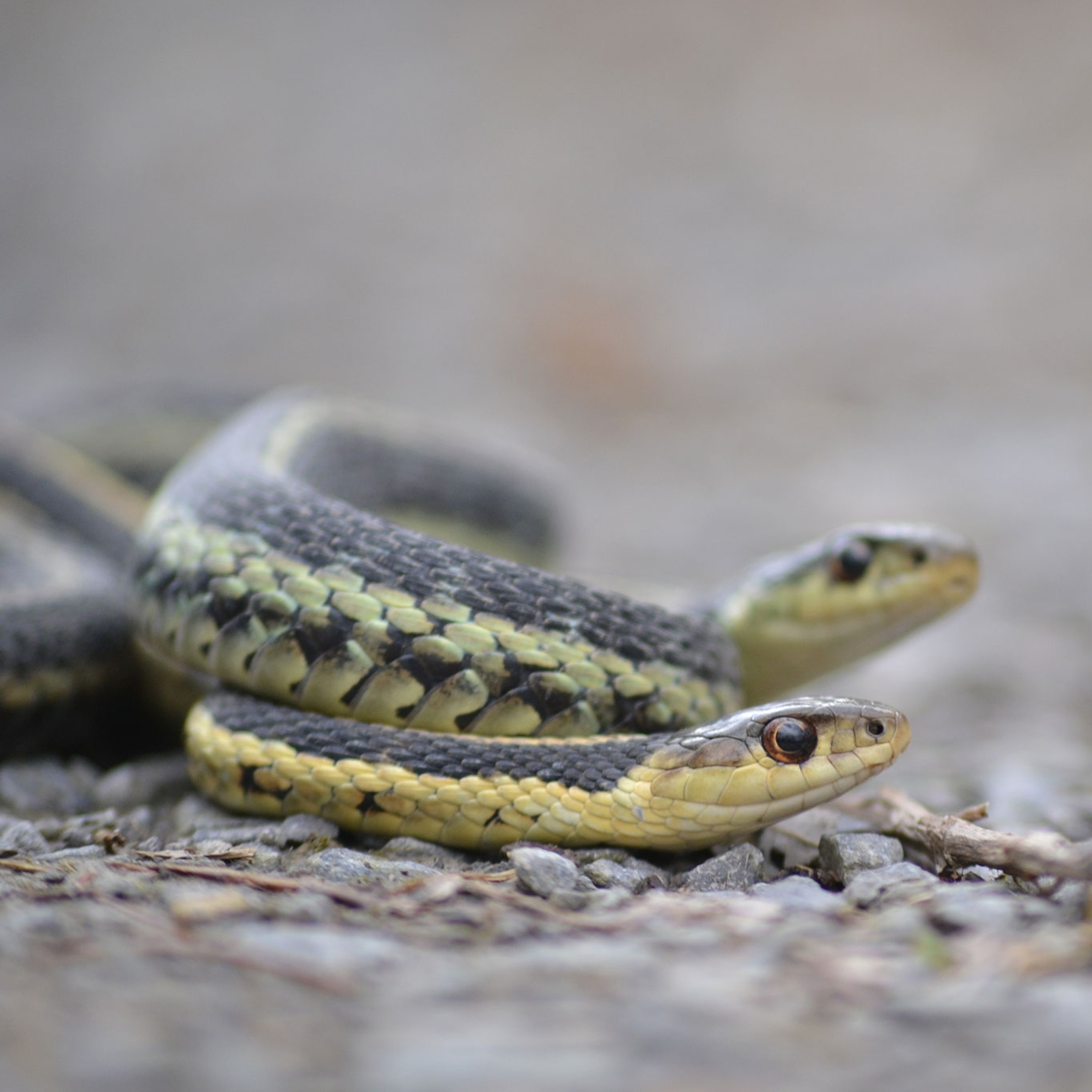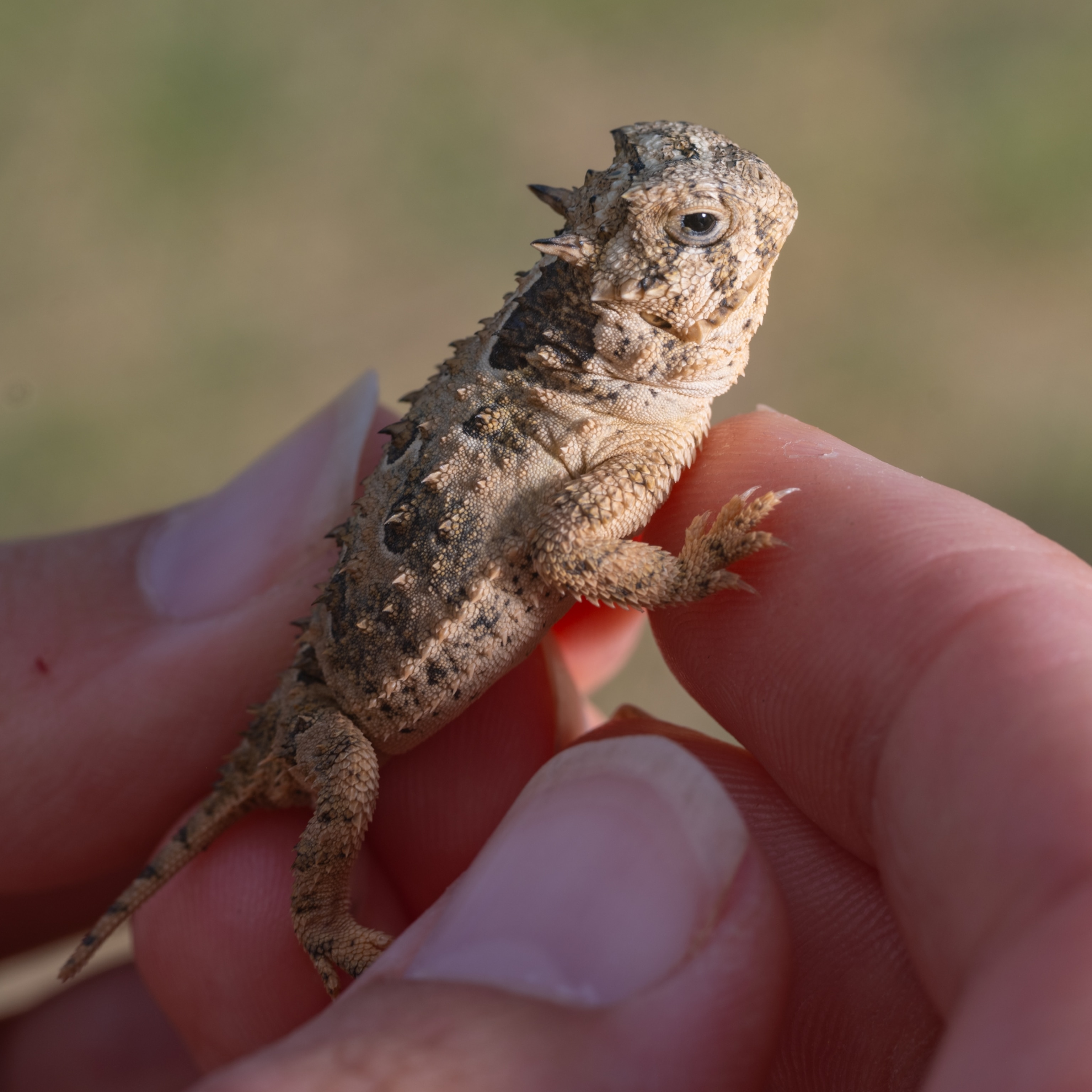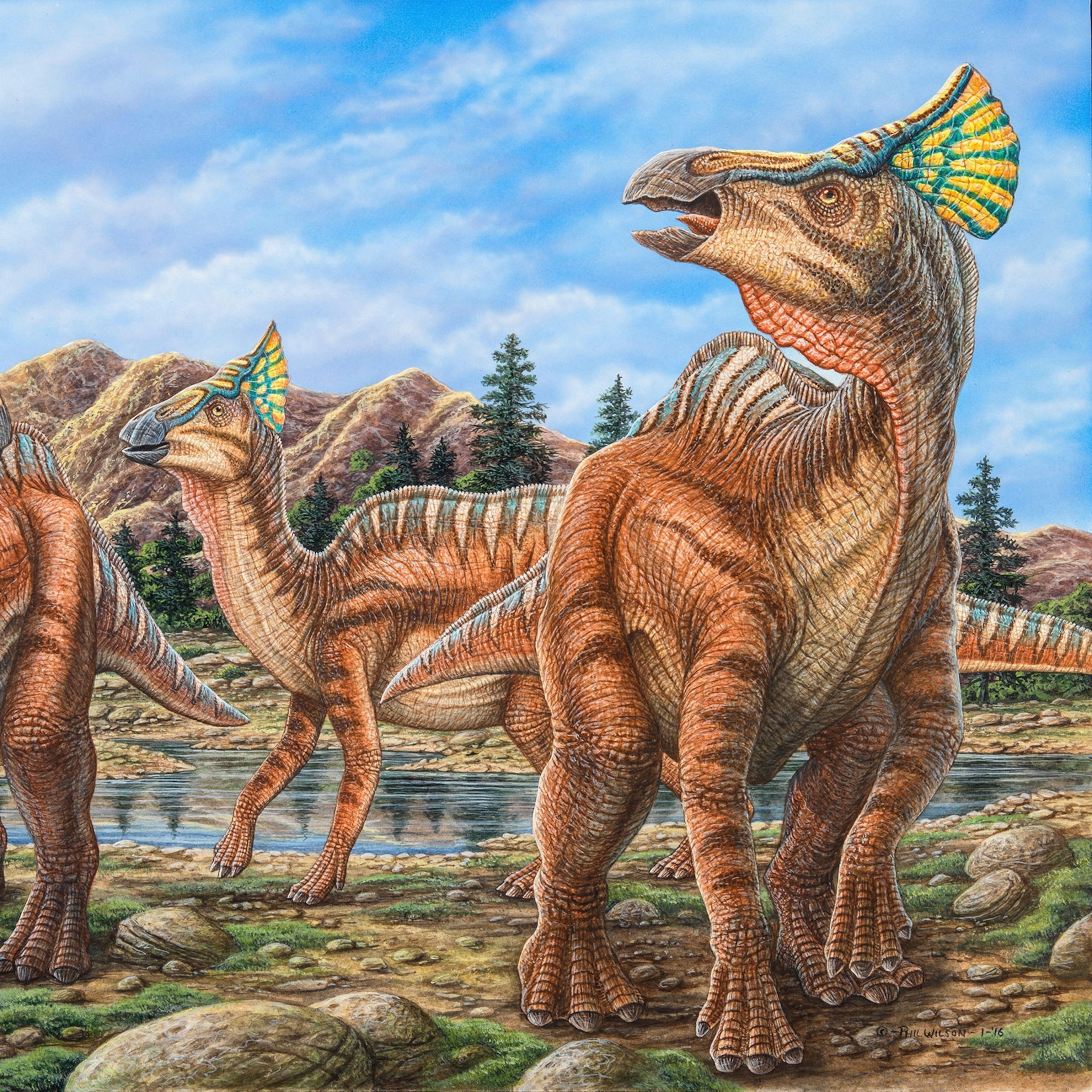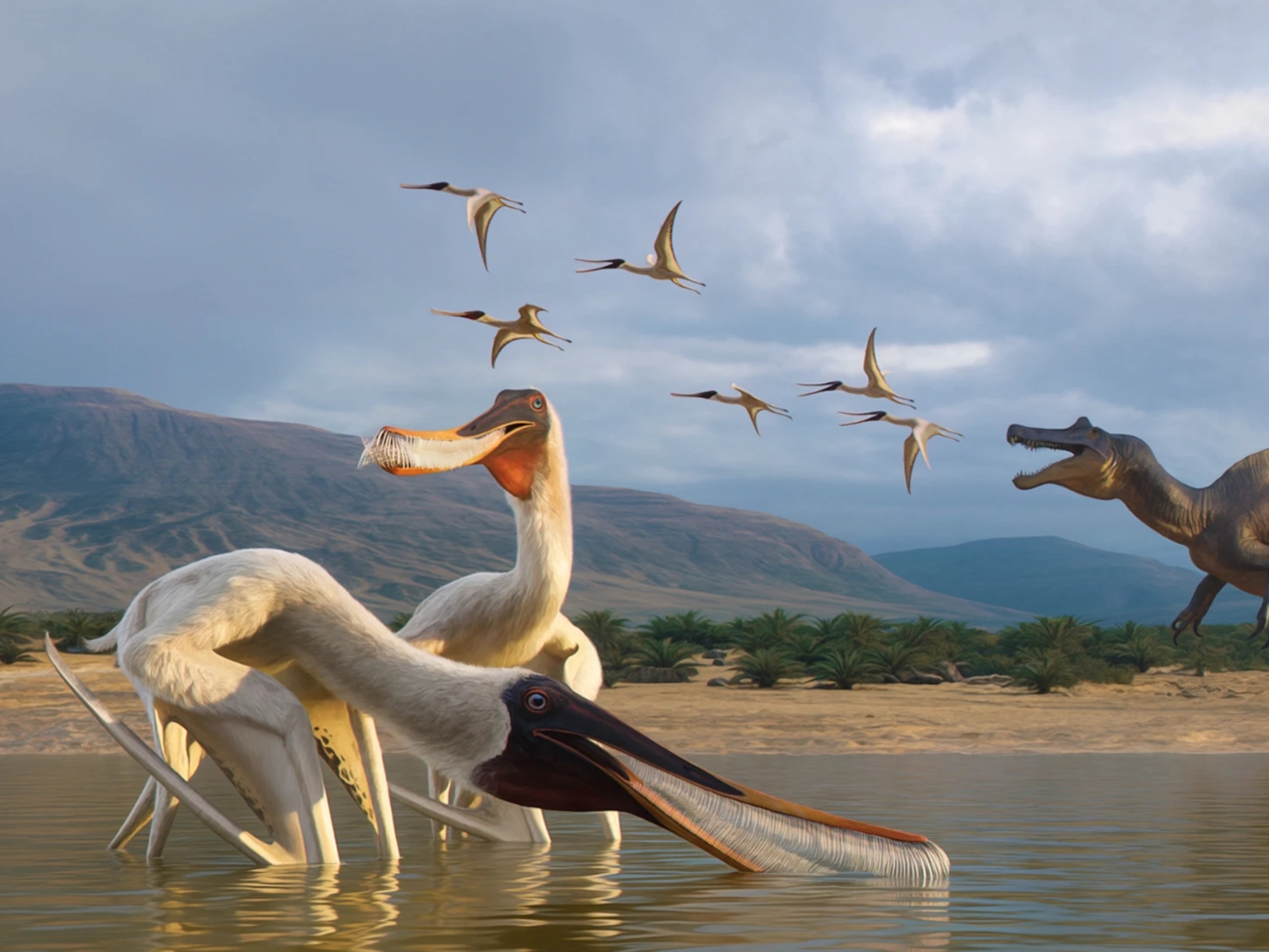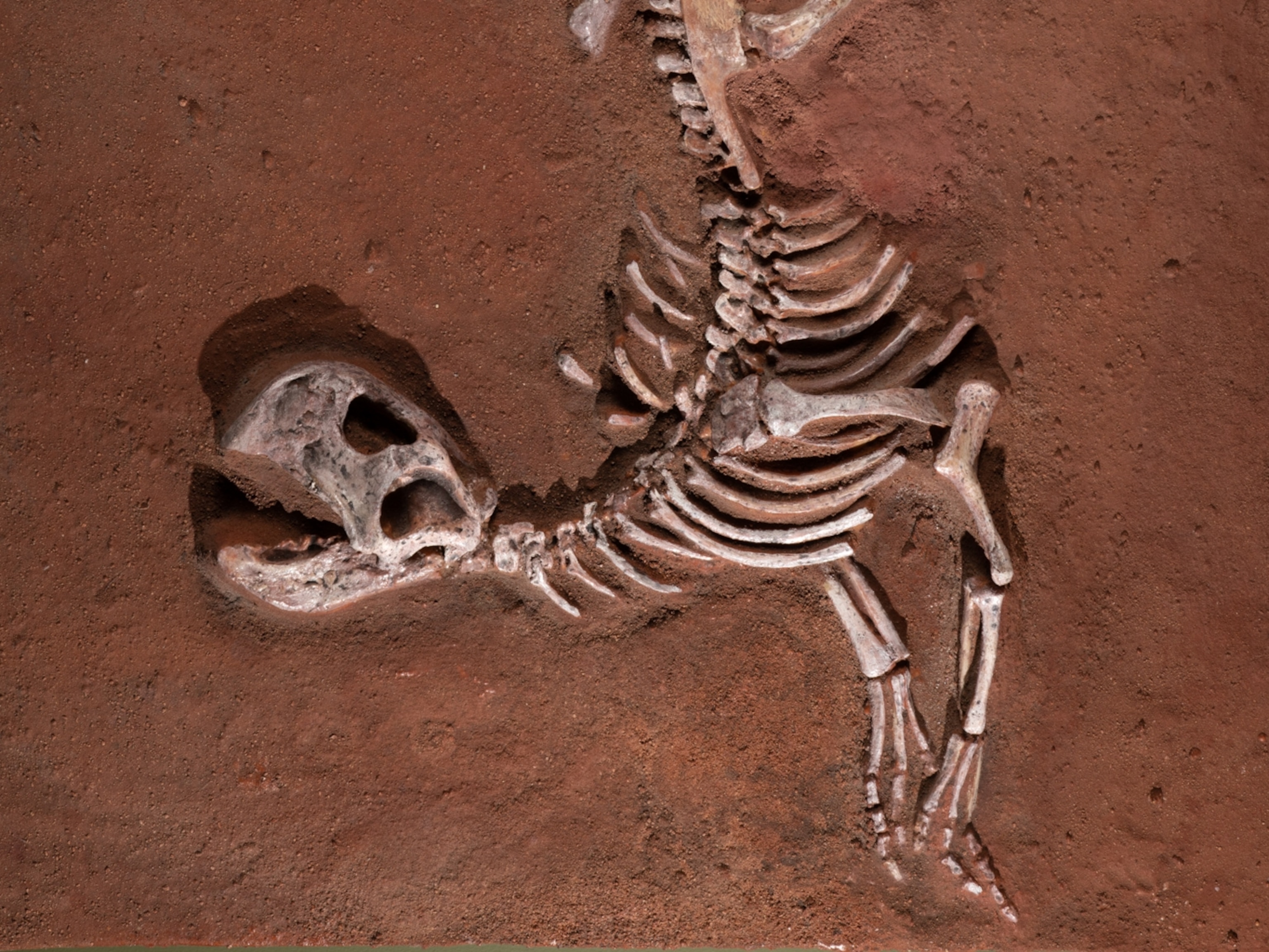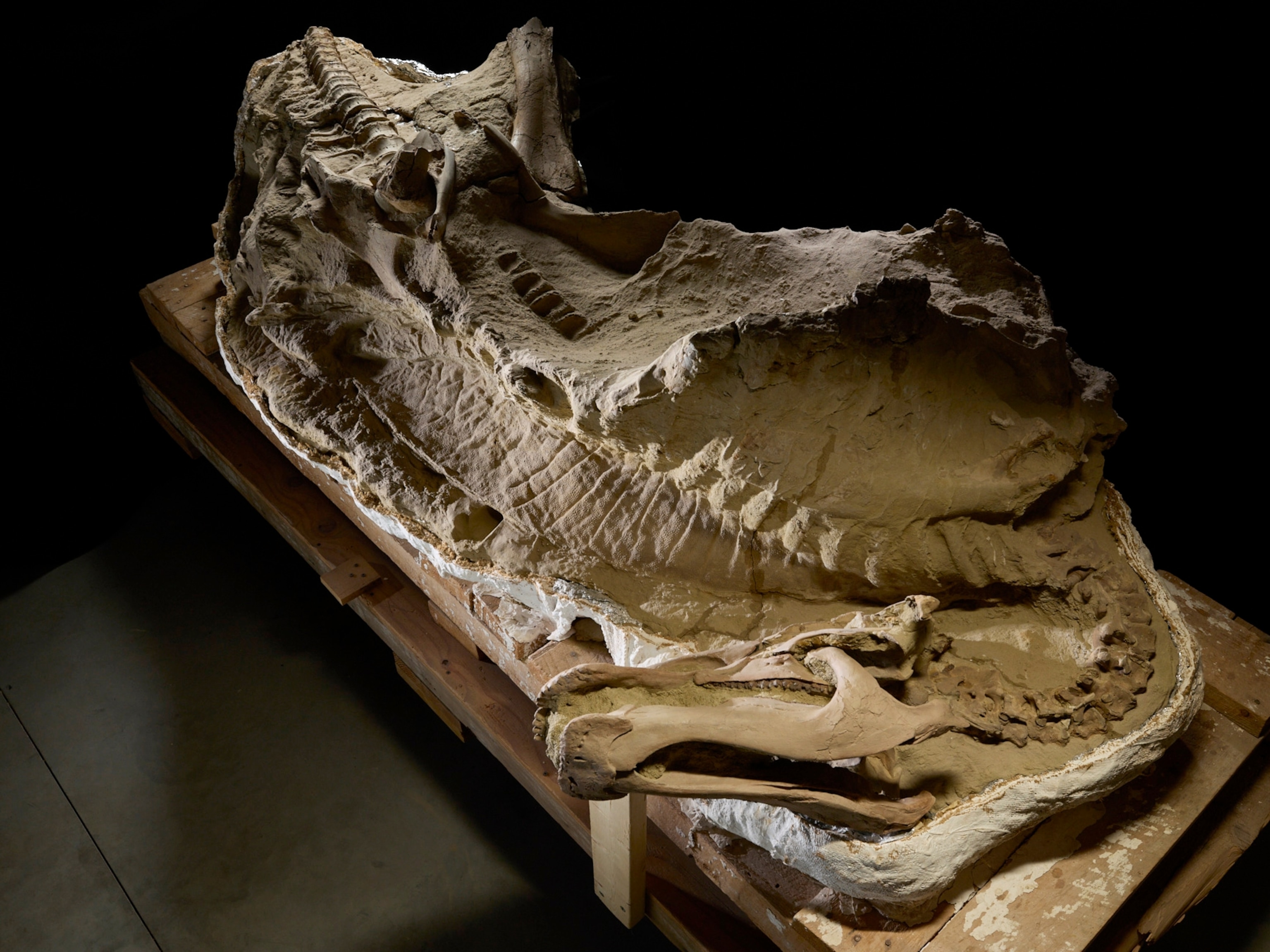Gold Dusters
They are the Earth’s pollinators. And they come in more than 200,000 shapes and sizes.
Row upon row, tomato plants stand in formation inside a greenhouse in Willcox, Arizona. Green stems poke from coconut-fiber blocks, reaching toward the glass-paned sky. Lab-coated technicians on elevated electric carts meticulously prune the crop. Eurofresh Farms harvests 130 million pounds of tomatoes a year from these perfect plants, grown on 311 acres in buildings outfitted with miles of pipe to ferry water and a network of steel wire above to capture the climbing vines. The ripening fruit smells faintly artificial, all sweetness and no soil.
But there is a natural presence here too. It reveals itself as a low hum that settles deep inside the ears: a thousand bumblebees hard at work.
To reproduce, most flowering plants depend on a third party to transfer pollen between their male and female parts. Some require extra encouragement to give up that golden dust. The tomato flower, for example, needs a violent shake, a vibration roughly equivalent to 30 times the pull of Earth's gravity, explains Arizona entomologist Stephen Buchmann, international coordinator of the Pollinator Partnership. "The scale is different," he says, "but consider that fighter pilots usually black out after half a minute at four to six g's."
Growers have tried numerous ways to rattle pollen from tomato blossoms. They've used shaking tables, air blowers, blasts of sound, and vibrators laboriously applied by hand to each bloom cluster. But the tool of choice in today's greenhouses? The humble bumblebee. Give a bee access to a tomato flower, and she'll glom on and quiver fiercely as she feeds, letting loose a cloud of pollen that hits the plant's stigma (the tip of the female anatomy) and also sticks to the bee's fuzzy body. She then ferries those particles to the next blossom. It's called buzz pollination, and it works like a charm.
No surprise that nature's design does the job best. What's astonishing is the array of workers that do it: More than 200,000 individual animal species, by varying strategies, help flowers make more flowers. Flies and beetles are the original pollinators, going back to when flowering plants first appeared 130 million years ago. As for bees, scientists have identified some 20,000 distinct species so far, and about one-fifth of those pollinate flowers in the United States. Hummingbirds, butterflies, moths, wasps, and ants are also up to the task. Snails and slugs smear pollen as they slide over flower clusters. Mosquitoes carry pollen for batches of orchids, and bats, with diverse muzzles and tongues adapted to tap differently shaped blossoms, move pollen for 360 plants in the Americas alone.
Even nonflying mammals do their part: sugar-loving opossums, some rain forest monkeys, and lemurs in Madagascar, all with nimble hands that tear open flower stalks and furry coats to which pollen sticks. Most surprising, some lizards, such as geckos and skinks, lap up nectar and pollen and then transport the stuff on their faces and feet as they forage onward.
Flowering plants—there are more than 240,000 species of them—have evolved in step with their pollinators, using sweet scents and bright colors to lure with the promise of a meal. Flower receptacles, like the animals' transport systems, are wonderfully varied, from tubes and gullets to flaps, brushes, and spurs. Match the right animal and plant parts—long tongue poked into narrow tube, furry face pressed into sticky brush—and pollen is soon on its way.
All that messy diversity, unfortunately, is not well suited to the monocrops and mega-yields of modern commercial farmers. Before farms got so big, says conservation biologist Claire Kremen of the University of California, Berkeley, "we didn't have to manage pollinators. They were all around because of the diverse landscapes. Now you need to bring in an army to get pollination done."
The European honeybee, first imported to the Colonies some 400 years ago, has been the domesticated pollinator workhorse in the U.S. since people began trucking them up and down highways in the 1950s. Now at least a hundred commercial crops in the U.S. rely almost entirely on managed honeybees, which beekeepers raise and rent out to tend to big farms. And although other species of bees—mason bees, for example—are five to ten times more efficient on a per-bee basis at pollinating certain fruits, honeybees have bigger colonies (30,000 or more bees per hive), forage over longer distances, and tolerate management and movement better than most insects. They're not picky—they'll spend their time on almost any crop. It's tricky to calculate what their work is truly worth; some economists put it at more than $200 billion globally a year.
Industrial-scale farming, however, may be wearing down the system. Honeybees have suffered diseases and parasite infestations for as long as they've been managed, but in 2006 came an extreme blow. In the U.S. and other countries, bees in massive numbers began to disappear over the winter. Beekeepers would lift the lid of a hive to find only the queen and a few stragglers, the worker bees gone. In the U.S. a third to half of all hives crashed; some beekeepers reported colony losses near 90 percent. The mysterious culprit was named colony collapse disorder (CCD), and it remains an annual menace—and an enigma.
When CCD first hit, many people, from agronomists to the public, assumed that our slathering of chemicals on agricultural fields was to blame. Indeed, says Jeff Pettis of the USDA Bee Research Laboratory, "we do find more disease in bees that have been exposed to pesticides, even at low levels." But CCD likely involves multiple stressors. Poor nutrition and chemical exposure, for instance, might pummel a bee's immunities before a virus finishes the insect off.
It's hard to tease apart factors and outcomes, Pettis says. New studies reveal that fungicides—not previously thought toxic to bees—can interfere with microbes that break down pollen in the insects' guts, affecting nutrient absorption and thus long-term health and longevity. Some findings pointed to viral and fungal pathogens working together. "I only wish we had a single agent causing all the declines," Pettis says. "That would make our work much easier."
As managed bees take a hit, so too do wild pollinators, whose work pollinating U.S. crops is worth about three billion dollars annually. Some notable bumblebee species are rarely seen anymore, with others becoming increasingly scarce. But few of the scores of native pollinators, less visible and less valued than the big-money honeybees, have been monitored long term.
What to do? Give pollinators more of what they need and less of what they don't, and ease the burden on managed bees by letting native animals do their part, say scientists. Reduced reliance on chemicals in agriculture is part of the solution, says Buchmann, since all animals need their immune systems in top shape to combat pathogens in their environment.
Meanwhile, habitat loss and alteration, he says, are even more of a menace to pollinators than pathogens. Claire Kremen encourages farmers to cultivate the flora surrounding farmland to help solve habitat problems. "You can't move the farm," she says, "but you can diversify what grows in its vicinity: along roads, even in tractor yards." Planting hedgerows and patches of native flowers that bloom at different times and seeding fields with multiple plant species rather than monocrops "not only is better for native pollinators, but it's just better agriculture," she says.
Pesticide-free wildflower havens, adds Buchmann, would also bolster populations of useful insects such as blue orchard bees—an extremely effective pollinator of almonds in California. Native bumblebees in Wisconsin aren't as finicky about cold, wet weather as honeybees, so managing the landscape for their benefit would mean more buzz in the orchards in early spring.
Even in the busiest cities, pollinators can be coddled with a little creativity. Recent studies show that bees off the farm have a healthier and more varied diet than those making the commercial-crop rounds. Rooftop beehives in New York City help urban gardens and Central Park foliage flourish. And ecologists are now transforming part of what was once a 2,200-acre landfill on Staten Island into a flowering meadow to give native pollinators a sugar boost. It's a fairly simple calculation. If there's habitat, they will come.
Fortunately too, "there are far more generalist plants than specialist plants, so there's a lot of redundancy in pollination," Buchmann says. "Even if one pollinator winks out, there are often pretty good surrogates left to do the job." The key to keeping our gardens growing strong, he says, is letting that diversity thrive.
Take away that variety, and we'll lose more than honey. Many flowering plants would disappear, and with them apples, peaches, pears, and a host of other crops. Without pollinators there'd be no raspberries, blueberries, or even milk on your cereal (cows feed on bee-pollinated alfalfa and clover). No coffee or chocolate. No canola, a biofuel crop. No more summer watermelon or Halloween pumpkins. U.S. almond growers, who provide 80 percent of the world's crop, employ a third or more of the country's commercial beehives during the growing season—a bee extravaganza that's been called the largest pollination event on the planet. That too would fizzle.
"We wouldn't starve," says Kremen. But without the birds and the bees (and the bats and the butterflies), what we eat, and even what we wear—pollinators, after all, give us some of our cotton and flax—would be limited to crops whose pollen travels by other means. "In a sense," she says, "our lives would be dictated by the wind."

